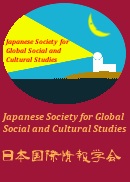Volume 14, Issue 1
No.1 (2017) The Journal of Japanese Society for Global Social and Cultural Studies 14_1
Displaying 1-8 of 8 articles from this issue
- |<
- <
- 1
- >
- >|
Original2017
-
2017Volume 14Issue 1 Pages 3-14
Published: December 24, 2017
Released on J-STAGE: December 24, 2017
Download PDF (844K) -
2017Volume 14Issue 1 Pages 15-26
Published: December 24, 2017
Released on J-STAGE: December 24, 2017
Download PDF (860K) -
2017Volume 14Issue 1 Pages 27-38
Published: December 24, 2017
Released on J-STAGE: December 24, 2017
Download PDF (998K) -
2017Volume 14Issue 1 Pages 39-49
Published: December 24, 2017
Released on J-STAGE: December 24, 2017
Download PDF (927K) -
2017Volume 14Issue 1 Pages 50-61
Published: December 24, 2017
Released on J-STAGE: December 24, 2017
Download PDF (1057K) -
2017Volume 14Issue 1 Pages 62-73
Published: December 24, 2017
Released on J-STAGE: December 24, 2017
Download PDF (848K) -
2017Volume 14Issue 1 Pages 74-83
Published: December 24, 2017
Released on J-STAGE: December 24, 2017
Download PDF (692K) -
2017Volume 14Issue 1 Pages 84-94
Published: December 24, 2017
Released on J-STAGE: December 24, 2017
Download PDF (634K)
- |<
- <
- 1
- >
- >|
